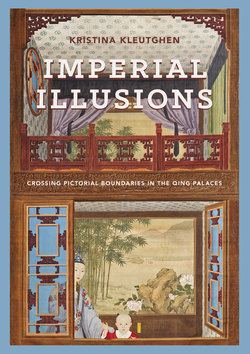Читать книгу Imperial Illusions - Kristina Kleutghen - Страница 92
На сайте Литреса книга снята с продажи.
Оглавлениеwest walls: wholly believable rooms with curtains or blinds, bookshelves full of books, objects in the room casting shadows, and sunlight shining on the floor through an open window in the paintings. He concluded by noting that “inside the room are several tables that are distantly visible, so orderly it is as if you can walk in [to the room]. Nearing it, it is still a wall. There was no linear perspective [xianfa] in antiquity: because it is as precise as this, I regret that the ancients did not see it, so I record it in particular.”66 In mistakenly regretting that people in the past did not have the opportunity to experience such paintings, Yao demonstrates just how profound Chinese art-historical amnesia was regarding its own illusionistic mural tradition.
Korean visitors to these churches made similar comments, demonstrating a consistent response to the deceptively three-dimensional quality of the paintings as well as the openness of the churches to receiving visitors. In 1720, Yi Kiji (1690–1722), son of the Joseon mission envoy to the Kangxi court, recorded seeing scientific instruments, optical devices, a book on natural history, and Western-style paintings. He initially mistook these paintings for real images and was subsequently embarrassed, but he also described his general impression of Beijing’s Jesuit churches and their paintings as “another world” (bie shijie).67 Hong Daeyong (1731–83), the Joseon envoy to Beijing in 1766, also marveled at his own sensory response and the emotions he experienced because of the paintings in these churches, specifically mentioning the method of spatial recession and calculation underpinning the illusions. Only after inquiring directly did he discover that one of the paintings “was not a real door but a picture on the wall in order to show the skillfulness to onlookers. I approached the wall doubtfully and found that it was not real but painted on the wall. This was enough for me to imagine the skillfulness of Western painting.”68 Although these paintings might not have been considered true art in the classical literati definition of the term, their effects on these highly educated Korean viewers were nonetheless considerable and remarkably consistent.
It is precisely this sort of skill and its ensuing deceptive effects on the viewer that Nian takes up in the eighth section (53v–56v) of The Study of Vision. It directly follows the section on illusionistic ceilings, the implication being that the next set of paintings would create the same sort of illusion directly in front of the viewer as the previous section of paintings did overhead. Using a detailed (if entirely idiosyncratic) method for depicting spatial recession (figure 2.11), the multipart illustration demonstrates how to depict a richly appointed room full of young boys actively engaged in riding hobbyhorses, brandishing toy weapons, tugging small animals on wheels behind them, and amusing themselves with a variety of other toys (figure 2.12). A canopied ceiling recedes toward a mountainous landscape visible beyond the background doorways in the far distance, potentially suggesting a garden area. This subject matter would have been immediately legible to a Chinese viewer. The multitude of boys and their playthings identifies the image as a “boys-at-play picture” (yingxitu), an auspicious traditional subject for paintings and woodblock prints that offered the viewer or recipient of such a work with a wish for
